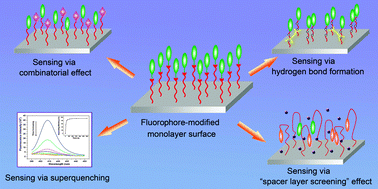The development of fluorescent chemical sensors has been an active research topic for many research fields. Design strategies play an important role in the sensing performance of the desired sensors. The use of chemically assembled monolayers of fluorophores to fabricate film sensors has shown several advantages: highly stable, re-useable, non-consumptive, and easy to be made into devices, etc. The present tutorial review gives an overview of the fluorescent film sensors based on chemical monolayer assemblies of fluorophores that have been developed in our laboratory along with some representative publications of others over the past decade. Different sensing mechanisms were taken into account in the sensor designs, including hydrogen-bond formation, static complex with quenchers, and more interestingly, the “spacer layer screening effect”. Various neutral organic chemicals and anions were targeted by these film sensors with great selectivity and sensitivity. In particular, the specific “spacer layer screening effect” imparts these particular type of films with tuned selectivity, opening a novel direction in developing fluorescent film sensors.

You have access to this article
 Please wait while we load your content...
Something went wrong. Try again?
Please wait while we load your content...
Something went wrong. Try again?


 Please wait while we load your content...
Please wait while we load your content...